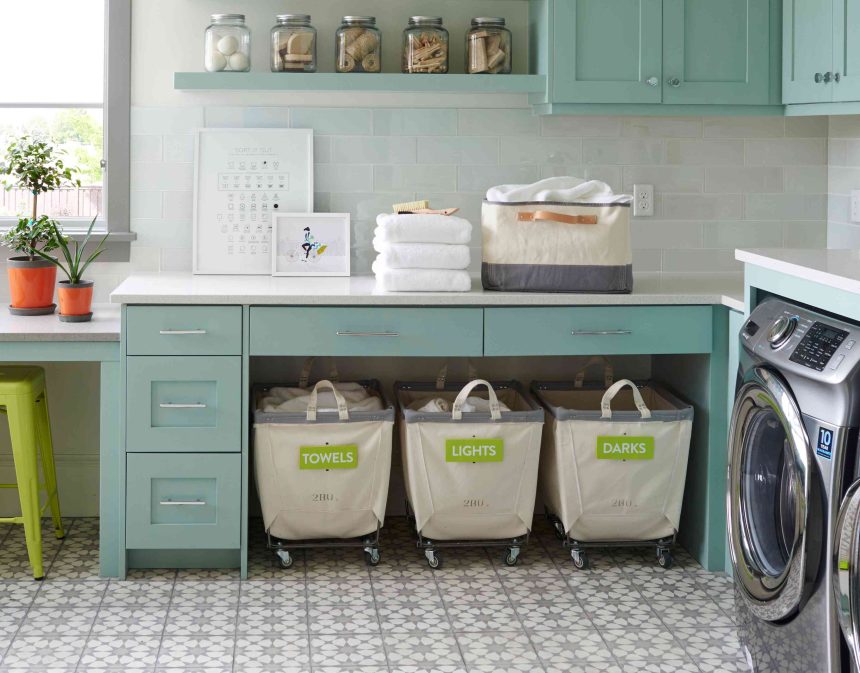When you first learned to do your own laundry, you were likely taught to wash colors, whites, and perhaps even lights separately from one another. The tactic makes sense to prevent darker pigments from bleeding onto the lighter items. The threat of a stray red sock turning an entire load of white clothes pink is enough to make most people stick with the habit. But is it absolutely necessary?
Today’s technology allows washers to use cold water cycles to clean clothes as efficiently as hot water. Not only does washing in cold water save energy, it also aids in color transfer prevention. So, if you have an up-to-date appliance, you might think it’s safe to toss in a load of laundry without taking the time to sort by color. However, Sammy Wang, fabric care senior specialist at P&G, disagrees.
“While laundry has become more advanced, there are still many different types of detergents, washing machines, and fabrics out in the market, so mishaps can still happen,” she says. “Sorting your clothes is a great way to help gain control over your laundry results, get a better clean, and help put your mind at ease.”
So, if you don’t want to risk a color transfer tragedy, it’s probably best to continue (or start) to sort your laundry for each load. With Wang’s help, we’ve put together a comprehensive list of the benefits of sorting, what categories (other than color!) you should consider, and everything else you need to know about separating your laundry to keep your things looking like new.
Benefits of Sorting Your Laundry
Wang explains there are several reasons why you should sort your laundry—and she doesn’t mean only by color. Read on to find out why you should be looking at fabric materials and soil levels when tackling your dirty laundry.
Prevent Color Bleeding
“When different colored garments are washed together, especially lights and colors, there is a risk of unwanted dye transfer due to color-bleeding,” Wang says. “Sorting clothes into separate loads based on color minimizes this risk and helps preserve the original colors of your garments.” She explains that textile manufacturers use fewer rinse cycles after the dying process to reduce their water consumption. While that’s good news for the environment, that means there’s an even higher chance of color transfer when you buy the item, making sorting laundry just as, if not more, relevant today than it was.
Preserve Clothing Quality
Along with sorting by color, Wang recommends doing laundry loads by material and their care instructions. “Different fabrics require different conditions, such as specific cycles,” she says. “Mixing clothes with various textures and fabric types can lead to friction and abrasion during the wash cycle—think jeans rubbing against a sweater.” Try reserving delicates for their own load and run them on a gentle cycle to prevent pilling, snags, and other damage.
Boost Cleaning Performance
If you’re really ambitious, you might want to sort your clothing further by its degree of dirtiness. “Separating heavily soiled items from lightly soiled ones prevents dirt and grime from transferring during the wash and allows for a more effective cleaning,” Wang says. Doing this will allow you to adjust detergent levels or use a targeted product, such as a sports detergent, for a load of sweaty workout clothes or sports uniforms.
How to Sort Your Laundry
If you’re on board with the benefits and want to make sure you’re getting the best clean for your clothes and other linens, sort your laundry by the following categories per Wang.
By color: Separate colors into darks, lights, and whites to prevent darker colors from bleeding onto lighter ones. This also allows you to use bleach on white items if necessary. Since denim is prone to color-bleeding, particularly on the first wash, Wang strongly suggests washing a new pair of jeans on their own.
By material: Feel free to sort by material or cycle type (i.e., bulky, heavy-duty, gentle, and so on) to prevent friction between fragile and abrasive fabrics. “If you don’t want to sort out clothes by fabric texture, we recommend using mesh garment bags for delicate items that could snag (like sweaters or sheer fabrics) to help protect them in the wash,” advises Wang.
By soil level: Avoid unnecessary dirt or sweat transfer by washing heavily soiled clothes and your everyday items separately.
By product preference: If you prefer to use products such as fabric softener, scent beads, or a specialty detergent on specific items and not others, Wang suggests sorting your laundry accordingly.
Pet considerations: To keep pet odors, hair, and the dirt they track in from mingling with your laundry, consider washing their blankets, beds, and towels separately.
Lint producers vs. receivers: According to Wang, some fabrics are lint producers (think cotton towels), while others are lint receivers (think corduroy pants). “If you know certain clothes shed a lot of lint and others tend to collect this lint, you may want to separate these items into different loads to prevent lint from transferring,” she says.
At the very least, Wang stands by sorting colors and utilizing tools, like a mesh bag for delicates or a dryer sheet to catch lint, if you don’t want to take the time separating everything else on the list. “Many people choose to wash all colors and fabric types together for convenience and accept the potential downsides of not sorting,” she says. “But if you prefer to sort to prevent mishaps, there’s no need to stop!”
In fact, the habit will not only make you happy about the quality of your clothes, it can also make you feel fresher. “In many cases, doing smaller loads can lead to better overall laundry results because clothes aren’t as tightly packed into machines, giving them more room to get clean,” Wang says.







